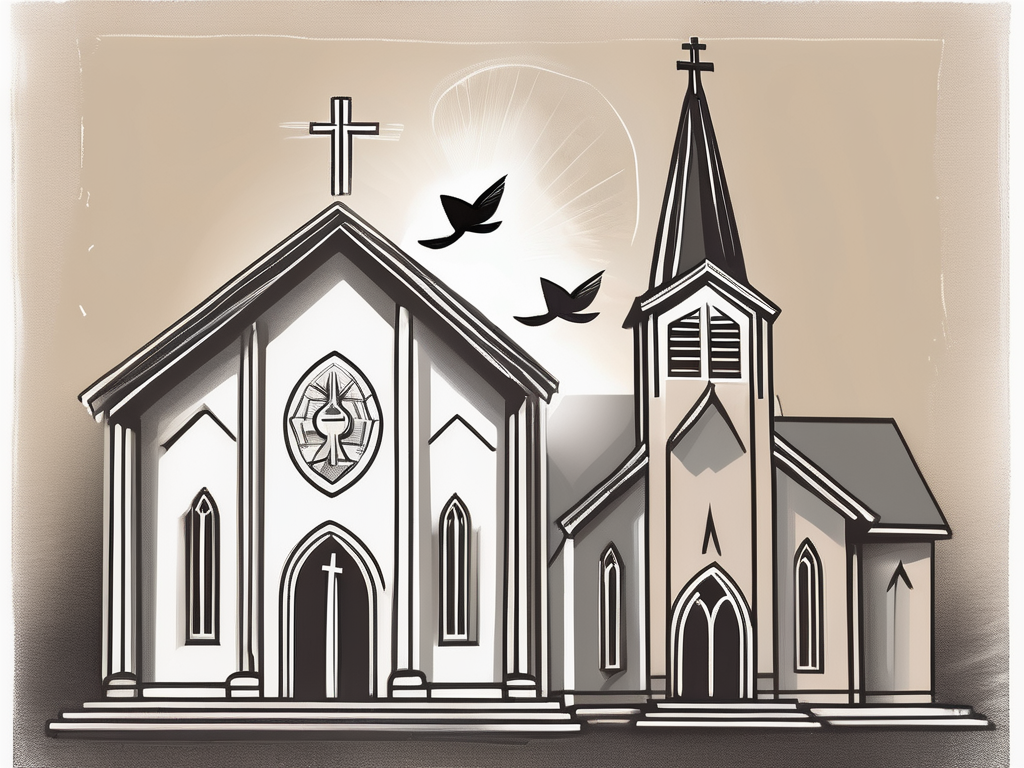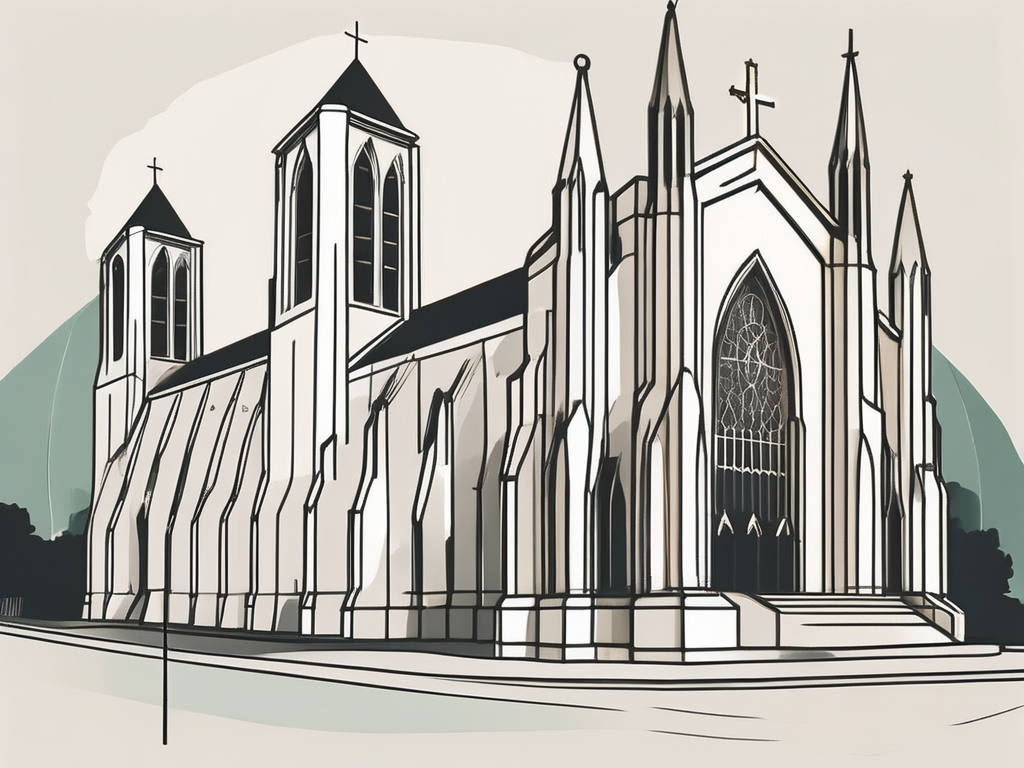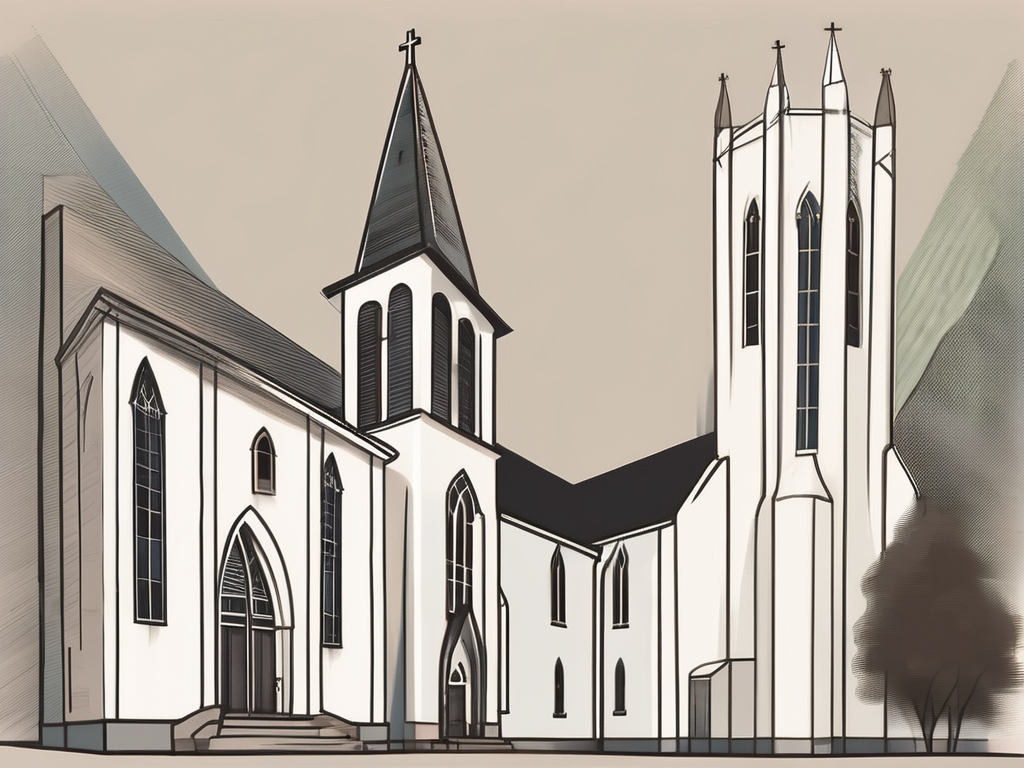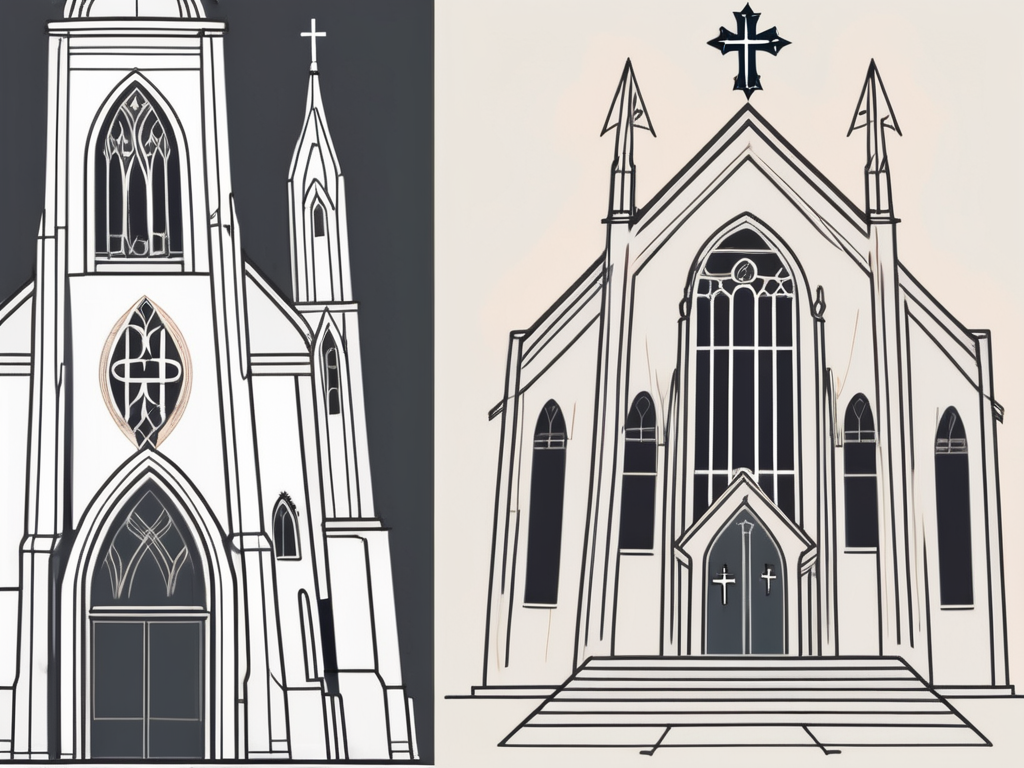Are you curious to learn about the similarities and differences between Anglicanism and Presbyterianism? In this article, we will explore the basics of these two Christian denominations and delve into their historical backgrounds, theological beliefs, worship styles, clergy structures, and social and cultural impacts. So, let’s dive right in!
Understanding the Basics: Anglicanism and Presbyterianism
Before we jump into the nitty-gritty details, it’s important to have a proper understanding of what Anglicanism and Presbyterianism are all about. Anglicanism, also known as the Anglican Church or Episcopal Church, originated in England and is known for its connection to the Church of England. On the other hand, Presbyterianism is a branch of Protestant Christianity that emerged from the teachings of John Calvin and has its roots in Scotland.
Origins and Historical Background of Anglicanism
Anglicanism traces its origins back to the English Reformation in the 16th century when King Henry VIII broke away from the Roman Catholic Church. This led to the establishment of the Church of England, which became the mother church of Anglicanism. Over the years, Anglicanism has evolved, incorporating both Catholic and Protestant elements.
The English Reformation was a period of religious and political upheaval in England. It was driven by a combination of factors, including the desire for political independence from the Pope in Rome, as well as theological disagreements with certain Catholic doctrines and practices. King Henry VIII’s decision to break away from the Roman Catholic Church was primarily motivated by his desire for an annulment of his marriage to Catherine of Aragon, which the Pope refused to grant.
With the establishment of the Church of England, the monarch became the Supreme Governor of the church, a unique characteristic of Anglicanism. This close relationship between the church and the state has shaped the development of Anglicanism throughout history, with the church often reflecting the values and beliefs of the ruling monarch and the government.
Origins and Historical Background of Presbyterianism
Presbyterianism, as we mentioned earlier, can be linked to the Protestant Reformation and the teachings of John Calvin. The Presbyterian Church has its roots in Scotland, where it gained prominence in the 16th century. The name “Presbyterian” refers to the system of church governance, wherein the decisions are made by a group of elders (presbyters) rather than a single bishop.
The Protestant Reformation, which began in the early 16th century, was a movement that sought to reform the practices and doctrines of the Roman Catholic Church. One of the key figures of the Reformation was John Calvin, a French theologian and pastor. Calvin’s teachings, known as Calvinism, had a significant impact on the development of Presbyterianism.
In Scotland, the Reformation was led by figures such as John Knox, who was greatly influenced by Calvin’s ideas. The Presbyterian Church in Scotland was established with the aim of creating a church that was free from the influence of bishops and had a more democratic system of governance. This system of church governance, known as Presbyterian polity, is characterized by the authority of the local congregation and the collective decision-making of the presbytery.
Throughout its history, Presbyterianism has been closely associated with the Scottish identity and has played a significant role in shaping the religious, social, and political landscape of Scotland. The Presbyterian Church of Scotland, also known as the Church of Scotland, remains the largest Christian denomination in the country.
Theological Differences between Anglicanism and Presbyterianism
One of the key areas where Anglicanism and Presbyterianism differ is in their theological beliefs. Let’s take a closer look at two significant aspects: views on sacraments and beliefs about church governance.
Views on Sacraments
In Anglicanism, there is an emphasis on the sacraments, particularly baptism and the Eucharist (also known as Holy Communion or the Lord’s Supper). Anglicans believe that these sacraments convey God’s grace to the recipients. Baptism, in Anglican tradition, is seen as the initiation into the Christian faith, a visible sign of God’s love and forgiveness. It is performed by a priest or bishop, who pours or sprinkles water on the person being baptized, symbolizing the washing away of sin and the new birth in Christ.
The Eucharist, on the other hand, holds a central place in Anglican worship. It is seen as a memorial of Christ’s sacrifice on the cross and a means of receiving his body and blood spiritually. Anglicans believe in the real presence of Christ in the Eucharist, although the exact nature of this presence is a matter of theological debate within the Anglican Communion.
In contrast, Presbyterianism views the sacraments as important symbols of faith, displaying obedience to Christ’s commands. While they acknowledge the significance of baptism and the Lord’s Supper, Presbyterians do not believe that these sacraments convey grace in the same way as Anglicans do. Rather, they are seen as acts of obedience and remembrance, symbolizing the believer’s identification with Christ and the community of faith.
Presbyterians practice infant baptism, similar to Anglicans, but the theological understanding behind it differs. For Presbyterians, infant baptism is seen as a sign of God’s covenant with believers and their children, symbolizing the child’s inclusion in the community of faith. It is an act of dedication, with the hope that the child will grow up to embrace their baptismal vows and profess their own faith in due time.
Beliefs about Church Governance
When it comes to church governance, Anglicanism has a hierarchical structure with bishops as the highest authority. This system is often referred to as the Episcopalian system. Bishops are seen as successors of the apostles and hold the authority to ordain priests and deacons. They are responsible for the oversight and pastoral care of the clergy and the faithful within their diocese.
Anglican bishops are organized into provinces and are led by a primate, such as the Archbishop of Canterbury in the Church of England. The primate holds a position of honor and serves as a symbol of unity within the Anglican Communion, which is a global network of autonomous churches that share a common heritage and worship tradition.
Presbyterianism, on the other hand, follows a governance model wherein the decisions are made collectively by a group of elders, known as the Presbyterian Session, who are chosen by the congregation. This system is based on the principle of “the priesthood of all believers,” emphasizing the shared responsibility and participation of the entire congregation in the life and ministry of the church.
Presbyterian churches are organized into regional bodies called presbyteries, which consist of ministers and elders from local congregations. These presbyteries are responsible for overseeing the work of the churches within their jurisdiction and making decisions on matters of doctrine, worship, and church discipline.
At the national level, Presbyterian churches are often governed by a General Assembly or a similar representative body, which meets regularly to discuss and decide on issues of common concern. This assembly is composed of ministers and elders elected from presbyteries, ensuring a broad representation of the church’s membership.
While both Anglicanism and Presbyterianism have distinct theological beliefs and approaches to church governance, they share a commitment to the worship of God, the proclamation of the Gospel, and the nurturing of Christian discipleship. These differences, rather than being points of division, can serve as opportunities for dialogue and mutual learning among Christians of different traditions.
Worship Styles: Anglican vs Presbyterian
Another fascinating aspect to explore is the worship styles in Anglicanism and Presbyterianism. Both traditions have distinct liturgical practices that shape their worship experiences.
Liturgical Practices in Anglicanism
Anglican worship is often characterized by its formal and liturgical nature. Anglican churches use a standardized prayer book, such as the Book of Common Prayer, which guides the order of service and the scripture readings. This structured approach brings a sense of reverence and tradition to their worship gatherings.
Within the Anglican tradition, there are various styles of worship that can be observed. Some Anglican churches follow a high church style, which incorporates elaborate rituals, vestments, and incense. This style of worship aims to create a sense of awe and majesty, drawing worshippers into a deeper experience of the divine presence.
On the other hand, there are Anglican churches that adopt a low church style, which emphasizes simplicity and accessibility. These services often have a more informal atmosphere, with contemporary music and a less rigid liturgical structure. The focus is on creating a welcoming environment where worshippers can engage with God in a personal and meaningful way.
Regardless of the specific style, Anglican worship places a strong emphasis on the sacraments, particularly the Eucharist or Holy Communion. The celebration of the Eucharist is seen as a central act of worship, where Anglicans believe they encounter the real presence of Christ.
Liturgical Practices in Presbyterianism
Presbyterian worship, while also drawing from liturgical elements, tends to have a more relaxed and adaptable style. The worship service commonly includes a sermon, singing of hymns, and prayers. The Presbyterian tradition places a strong emphasis on the Word of God and the preaching of the Scriptures.
Presbyterian churches often follow a structured order of worship, known as the “Directory for the Public Worship of God.” This directory provides a framework for the worship service, but allows for flexibility and adaptation to the specific needs of the congregation. The focus is on creating a worship experience that is relevant and engaging for the worshippers.
One distinctive feature of Presbyterian worship is the role of the congregation. Presbyterians believe in the “priesthood of all believers,” which means that every member of the congregation has a role to play in the worship service. This can include leading prayers, reading scripture, or participating in the singing of hymns. The active involvement of the congregation creates a sense of community and shared responsibility in worship.
In addition to the regular worship service, many Presbyterian churches also observe sacraments such as baptism and the Lord’s Supper. These sacraments are seen as visible signs of God’s grace and are celebrated with reverence and joy.
Overall, while both Anglicanism and Presbyterianism have liturgical practices that shape their worship styles, there are distinct differences in their approach. Anglican worship tends to be more formal and structured, with a variety of styles ranging from high church to low church. Presbyterian worship, on the other hand, is characterized by its adaptability and emphasis on the Word of God. Both traditions seek to create meaningful worship experiences that draw worshippers closer to God.
Role of Clergy in Anglicanism and Presbyterianism
The role of clergy and their structure within the Anglican and Presbyterian churches differ significantly. Let’s explore these variations more closely.
Clergy Structure in the Anglican Church
In the Anglican Church, ordained ministers are referred to as priests or deacons. Bishops hold the highest rank and oversee a specific geographic area called a diocese. The clergy play an essential role in conducting worship services, administering sacraments, and providing spiritual guidance to the congregation.
Clergy Structure in the Presbyterian Church
The Presbyterian Church follows a different clergy structure. The ordained leaders are known as ministers or pastors and are responsible for preaching, teaching, and pastoral care. The congregation has a say in selecting and calling their ministers, which reflects the importance of the community’s involvement in decision-making.
Social and Cultural Impacts of Anglicanism and Presbyterianism
Beyond their theological and worship differences, both Anglicanism and Presbyterianism have had significant impacts on society and culture. Let’s take a glimpse at how they have influenced the world around them.
Anglicanism’s Influence on Society and Culture
The Anglican Church played a vital role in the spread of Christianity during the British colonial era. Anglicanism’s influence can be seen in the legal systems, education, and cultural practices of many countries under British rule. In addition, Anglicanism has been a driving force in promoting social justice movements and addressing global issues.
Presbyterianism’s Influence on Society and Culture
Presbyterianism’s influence can be observed in various spheres of society as well. Particularly in Scotland and the United States, Presbyterian churches have been pivotal in shaping public education systems and advocating for social reforms. The emphasis on community involvement and social responsibility in Presbyterianism has undoubtedly left a lasting impact.
In conclusion, Anglicanism and Presbyterianism are two distinct Christian traditions with their own unique histories, beliefs, worship styles, clergy structures, and societal contributions. By understanding these differences and appreciating the rich heritage of both denominations, we can foster greater understanding and respect within the broader Christian community.












